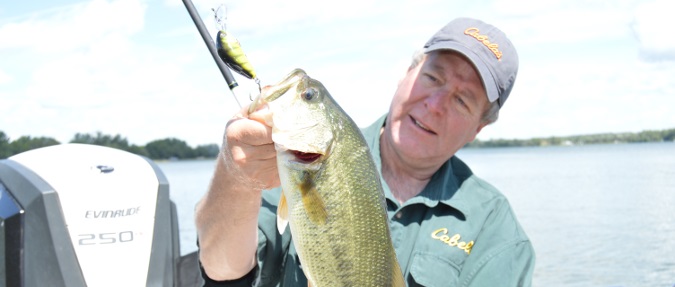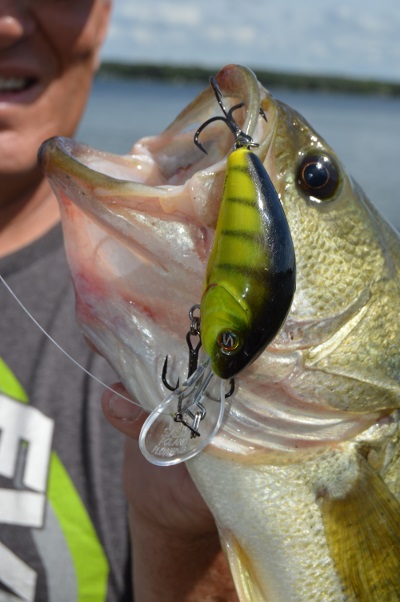
I went fishing last week. We were after largemouth bass, and we were on a good largemouth bass lake. They were spread out over and along the weedline and also on off-shore submerged weedbeds. When the bass are in locations such as these, casting crankbaits is an outstanding way to locate and catch them. So, that’s what we did: We threw crankbaits. Here’s how we went about catching a bunch of bass on crankbaits.

We did some sonar work to start. The mapping function of our depthfinder showed us where weeds such as cabbage and coontail should be, so we headed to those areas. The A127 Raymarine sonar that we were using enables us to look at the map and the sonar at the same time, and that’s so helpful. Once we found the deep weed edge we moved a bit deeper. The best areas where those where the weeds came to about six feet from the surface, with the deep edge of the weeds being twelve to fourteen feet deep.
We cast to the top of the weedbed and started reeling. We could easily feel the baits hitting the tops of the weeds. As the bait moved into deeper water, we reeled faster to get the bait to run deeper. Often times the strike would occur just as we ripped the bait free from a weed. These bass were not real aggressive, but when they saw the bait change speed as it came free from the weeds, that’s when the strike usually happened. We were using Salmo 6.5 Hornet crankbaits. These baits cast very well: You can make extremely long casts with them, and that can be a big advantage when the water is clear or when you’re covering a large area that doesn’t vary a lot in depth. The 6.5 has become the go-to bait for many crankbait enthusiasts.
We kept the boat about thirty feet, maybe a little more, off the edge of the weedline as we covered water. We would go for five or ten minutes without action, then we would catch several in a short period of time out of the same area. We got to looking around and found the areas that held the most bass were where there was an irregularity on the weedline. There was maybe a point or a pocket in the weeds, and that’s where the fish were. Another type of area that held noticeably more bass was where the weed type changed. We would be moving along and hooking cabbage weeds. We knew they were cabbage because every now and then the weeds would stay attached to our bait. Then we quit hooking cabbage and hooked coontail. When the weeds changed, the action usually picked up right along that weed transition area.
The lake we were fishing had some color in it: We could see down about six feet. Baits that were brighter were best. In clear water, natural appearing baits are often favored, but try different colors until the productive one is determined.
Lure size can be a consideration. When the fish are finicky, smaller lures are often better. Smaller lures are often better in the spring also. As the water warms, big lures will be better, and in the fall, use the biggest crankbait that the fish will hit. You’ll catch bigger fish with bigger baits.
Crankbaits are fish catching machines right now, and they will be well into the fall. Largemouth bass like’em, but so do walleyes, muskies, northern pike and even crappies. Crankbaits resemble in shape the food that most fish eat naturally.
When using crankbaits, I like to use a net, and I also have a needle-nose for hook removal. The net and the needle-nose make things better for the fish and your fingers.
From now until deep into the fall, crankbaits will be fish-catchers. Give them a try and find out for yourself just how good they can be.
To see all the most recent episodes of the Fishing the Midwest television series, new fishing related tips, and fishing articles from the past, go to fishingthemidwest.com. If you do Facebook, check us out for a variety of fishing related things.
by Bob Jensen
